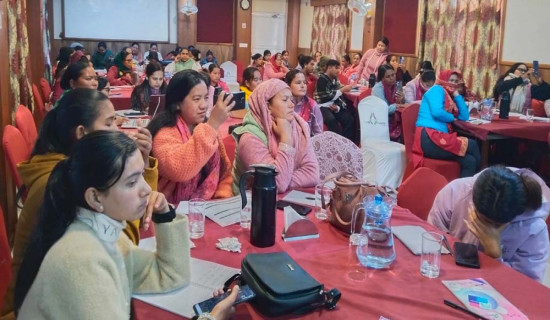- Thursday, 25 December 2025
Formalising Remittance Is Not Easy
Nepal is a least developed country with a small economy. Unemployment is one of the problems besetting the country. That is why many Nepalis seek job opportunities in foreign lands. They seek jobs in Malaysia, Qatar, Saudi Arabia, the United Arab Emirates, Bahrain, Kuwait, Oman, South Korea, Cyprus and other countries. Although India is not often mentioned while it comes to foreign employment destinations, the number of migrant workers working in India is high because Nepal and India are close neghbours with open borders.
The remittance sector has greatly contributed to the economy of Nepal. The economy of the country depends largely on remittances, taxes and foreign aid. As over 1,500 Nepalis leave the country daily for foreign countries for lack of job opportunities in the country, the inflows of remittances into the country are but natural. In 2018/19, the country received Rs. 879.36 billion in remittance. Likewise, the country received Rs. 875.00 billion in 2019/20, Rs. 961.05 billion in 2020/21 and Rs. 1,007.3 billion in 2021/22 respectively. During 2021/22, the remittance sector contributed 20.8 per cent to the national GDP.
WB report
As per the World Bank Report “Migration and Development”, the remittance is expected to rise to US$ 8.5 billion in 2022 from US$ 8.2 billion in 2021. The report cites an increase in vaccinations and lifting of travel restrictions in Gulf Cooperation Council (GCC) countries as the main reason for an increase in remittance inflows. The GCC countries are the main destinations for Nepali migrant workers. In recent times, the conditions in these countries have become favourable.
As per the report, the flow of remittances to South Asia is expected to grow by 3.5 per cent to reach US$ 163 billion this year (2022). Nepal and India are expected to benefit largely from this. It may be noted that the COVID-19 pandemic severely battered Nepal and other countries for the last two years. The menace of the pandemic is receding in Nepal and other countries. However, China and some other countries are still grappling with the pandemic with a surge in COVID-19 infections.
It would be pertinent to mention that the remittance sector is not fully formalised in Nepal. There are many migrant workers who prefer to send money back home through the informal channels such as the hundi system. The cost of sending remittance money home is high. So Nepali migrant workers prefer the hundi system to the banking channels although the former is illegal. Their main concern is that the hard-earned money they send back home should reach their families at a minimum charge. The domestic remittance charge is also high but the introduction of the payment platform connectIPS has reduced the charge: a maximum of Rs. eight for a bank transfer.
The Nepal Rastra Bank (NRB) has lowered the transaction limit to Rs. 25,000 per day from Rs. 100,000 so as to dissuade people from seeking the services of remittance intermediaries and to encourage people to use the banking channels such as the connectIPS digital mode of money transfer. Encouraging people to use such a digital mode also promotes financial literacy among them. And at the same time, they will keep remittance intermediaries at bay. The Nepal Rastra Bank has also increased the daily threshold of remittance from Rs. one million to Rs. 1.5 million. Moreover, non-resident Nepalis (NRNs) have been permitted to open foreign currency savings accounts in Nepali banks.
There is no data on how much remittance money comes into Nepal through the informal channels. The hundi system is illegal in the country. Still, many migrant workers are using the system. Although commercial banks give interest on remittance accounts at one per cent higher than that on normal accounts, the government has not been able to take all migrant workers into confidence. The government as well as banks should take effective measures to bring remittance money to the country through the banking channels by offering migrant workers incentives and lowering, or doing away with, if possible, remittance charges.
Woes of migrant workers
Although it seems the remittance sector is a flourishing source of cash flows, migrant workers have woes galore. Most of them have to work hard in foreign countries. The working environment is often harsh. They are not getting salaries and other benefits as per their contracts. Further, most of them have to do jobs alien from the ones promised by manpower agents. Some are left high and dry in foreign lands and others have to return to their homeland in coffins. Whenever, they fall sick or meet with accidents, they have to face adversity.
The government should take the initiative to mitigate the woes of such migrant workers. Before sending them to foreign countries, they should be imparted training on skilling, reskilling or upskilling. The government may conduct such training in collaboration with donor agencies, national and international organisations, the private sector, civil society organisations and other stakeholders. The government can also impart training to those migrant workers who have returned home and who want to pursue entrepreneurship in the country itself. The skills they have learnt in foreign countries can be utilised in the country, which will be beneficial for both them and the country. Further, the government should create an environment for remittance money to be utilised as productive investments, which will help boost the economy of the country.
(Maharjan has been regularly writing on contemporary issues for this daily since 2000. uttam.maharjan1964@gmail.com)

















